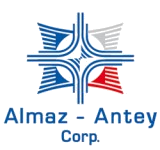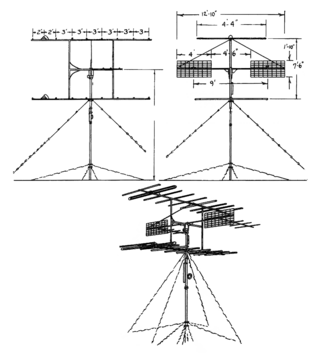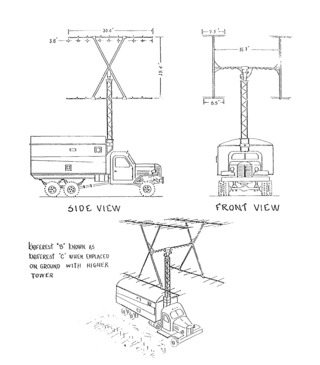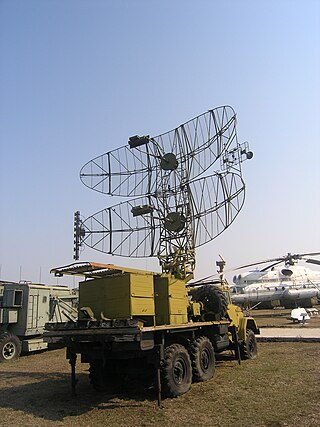
The United States Space Surveillance Network (SSN) detects, tracks, catalogs and identifies artificial objects orbiting Earth, e.g. active/inactive satellites, spent rocket bodies, or fragmentation debris. The system is the responsibility of United States Space Command and operated by the United States Space Force.
Pirinçlik Air Base, also known as Pirinçlik Air Station, formerly Diyarbakır Air Station, was a 41-year-old American-Turkish military base near Diyarbakir, Turkey. Notable base commanders include Col. Dale Lee Norman. It was known as NATO's frontier post for monitoring the former Soviet Union and the Middle East, completely closed on 30 September 1997.

JSC Concern VKO "Almaz-Antey" is a Russian state-owned company in the arms industry, a result of a merger of Antey Corporation and NPO Almaz, unifying some of the national military enterprises, in particular, the developers of anti-aircraft defence and cruise missile systems. The organisation is headquartered in Moscow and is the world's eighth-largest defence contractor measured by 2017 defence revenues. In 2017, Almaz-Antey had arms sales of $9.125 billion.

The "Pegmantit 3" or P-3 was an early VHF radar developed and operated by the former Soviet Union.

The "Pegmantit 8" or P-8 was an early 2D VHF radar developed and operated by the former Soviet Union.

The "Pegmantit 10" or P-10 was an early 2D VHF radar developed and operated by the former Soviet Union.

The P-12 "Yenisei" was an early VHF radar developed and operated by the former Soviet Union.

The P-18 or 1RL131Terek is a 2D VHF radar developed and operated by the former Soviet Union.

The P-40"Armour" or 1S12 is a 3-D UHF radar developed and operated by the former Soviet Union.

The P-15"Tropa" or 1RL13 is a 2D UHF radar developed and operated by the former Soviet Union.
The P-70 or "Lena-M" was a static 2D VHF radar developed and operated by the former Soviet Union.

The P-19"Danube"1RL134 is a 2D UHF radar developed and operated by the former Soviet Union. The radar was also known by the name "Renata" in Poland and "Dunai" in the former German Democratic Republic.

The P-30"Khrustal", also referred to by the NATO reporting name "Big Mesh" in the west, is a 2D E band/F band radar developed and operated by the former Soviet Union.

The P-20"Periskop", also referred to by the NATO reporting name "Token" in the west, is a 2D E band/F band radar developed and operated by the former Soviet Union.

The P-35, also referred to by the NATO reporting name "Bar Lock" in the west, is a 2D E band/F band radar developed and operated by the former Soviet Union.

Eglin AFB Site C-6 is a United States Space Force radar station which houses the AN/FPS-85 phased array radar, associated computer processing system(s), and radar control equipment. Commencing operations in 1969, the AN/FPS-85 was the first large phased array radar. The entire radar/computer system is located at a receiver/transmitter building and is supported by the site's power plant, fire station, 2 water wells, and other infrastructure for the system. As part of the US Space Force's Space Surveillance Network its mission is to detect and track spacecraft and other manmade objects in Earth orbit for the Combined Space Operations Center satellite catalogue. With a peak radiated power of 32 megawatts the Space Force claims it is the most powerful radar in the world, and can track a basketball-sized object up to 22,000 nautical miles (41,000 km) from Earth.

The Nizhny Novgorod Research Institute of Radio Engineering (NNIIRT) is a Russian electronics company specializing in the development and manufacturing of radar equipment. It is a subsidiary of the Almaz-Antey group.
This is an overview of Russian early-warning radars for air surveillance, and related design bureaus.

The Nebo-M or Nebo-ME also known as RLM-ME or 55Zh6ME is an integrated multi-functional radar system that features a multiple programmable multi-band design radars and a central data fusion. The radar began to be investigated in 1984. The radar complex is made up of a command post module and one to three different radars which are deployed on separate 8x8 24-ton trucks. The manufacturer claims this radar system can detect 5th generation aircraft like the F-22 and F-35 and detect long-range ballistic missile launches. Nebo-ME is an export version with some downgraded characteristics.

The Nebo-SVU is a very high frequency multi-functional radar and first radar with an active electronically scanned array antenna operating in the metric wavelength. The radar was introduced in 2001 as a replacement for Nebo-SV. It can locate aircraft or other flying object with 0.1 m2 radar cross-section at 100 km (62 mi).

















